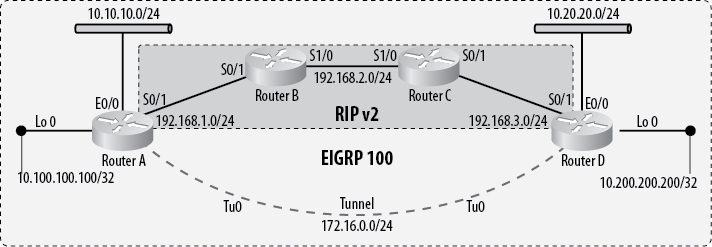GRE Tunnels and Routing Protocols
The introduction of a routing protocol across a GRE tunnel can cause some
interesting problems. Take, for example, our network, now altered as shown
in Figure 12-3. This time, we have the
links between the routers updating routes using RIPv2. The other
interfaces on Router A and Router D are included in RIP using
the redistribute connected
command. EIGRP is running on all interfaces on Routers A and D with the
exception of the serial links, which are running RIPv2.
While this may look a bit odd, consider the possibility that the Routers B and C are owned and operated by a service provider. We cannot control them, and they only run RIPv2. We run EIGRP on our routers (A and D) and want to route between them using EIGRP.

Figure 12-3. Recursive routing example
Here are the pertinent configurations for Router A and Router D (remember, in this scenario, Routers B and C are beyond our control):
Router A:
interface Loopback0 ip address 10.100.100.100 255.255.255.255 ! interface Tunnel0 ip address 172.16.0.1 255.255.255.0 tunnel source Loopback0 tunnel destination 10.200.200.200 ! interface Ethernet0/0 ip address 10.10.10.1 255.255.255.0 ! interface Serial0/1 ip address 192.168.1.1 255.255.255.0 router eigrp 100 network 10.10.10.0 0.0.0.255 network 10.100.100.0 0.0.0.255 network 172.16.0.0 0.0.0.255 no auto-summary ! router rip version 2 redistribute connected ...
Get Network Warrior, 2nd Edition now with the O’Reilly learning platform.
O’Reilly members experience books, live events, courses curated by job role, and more from O’Reilly and nearly 200 top publishers.

